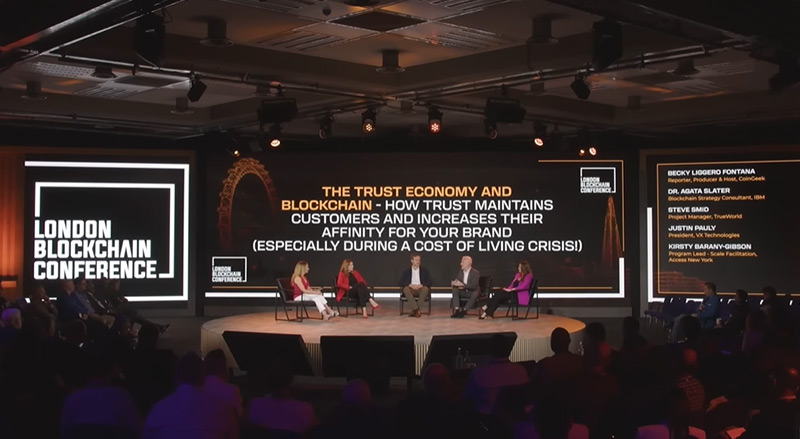The relationship between the trust economy and blockchain technology has emerged as a powerful catalyst for building and growing customer loyalty. As traditional business models evolve, consumers are placing an increasing premium on trust, transparency, and security.
In this context, the BSV blockchain, with its distributed and tamper-resistant nature, has become a cornerstone for fostering trust in transactions and data integrity. This marriage of the trust economy and blockchain not only redefines the parameters of commerce but also sets the stage for businesses to cultivate enduring customer relationships.
This was unpacked in more detail during a panel at the recent London Blockchain Conference hosted by CoinGeek’s Becky Liggero. The panellists included:
- Dr. Agata Slater (Blockchain Strategy Consultant at IBM);
- Steve Smid (Project Manager of TrueWorld);
- Justin Pauly (President of VX Technologies);
- Kirsty Barany-Gibson (Program Lead – Scale Facilitation, Access New York).
Provenance and trust with IBM and Gate2Chain
One of the key ways companies can win their customers’ trust and confidence is through transparency. This includes being open about where their products are sourced and how they are transported, Slater said.
One platform that provides for this transparency is Trace. Trace is an innovative application developed by Gate2Chain and IBM and powered by the BSV blockchain, explained Slater. It eliminates the need for native tokens, miner fees, and the typical volatility encountered with blockchain technology. With the Trace platform, users can generate a digital twin, akin to a token, for any object and securely store essential data within it.
By harnessing the immutable nature of the blockchain, the presence of a digital twin enables the electronic management of physical objects, ensuring transparency for all participants within the supply chain.
Through the digital twin, customers can authenticate and trace the origin of an item throughout its entire journey, providing tangible value to the intangible notion of ownership. In the event of theft, marking the digital twin as stolen renders the item useless to the thief, similar to how a stolen credit card becomes ineffectual.
ESG and the climate crisis
Another key focus of the discussion was the climate crisis and ESG considerations. As the world grapples with the persistent spectre of climate change, it has become imperative to devise efficient and sustainable solutions across all industries.
Smid explained that Trueworld, which is built on the BSV blockchain, enables real-time monitoring of environmental indicators and sustainability claims. By capturing what the team describes as the ‘vital signs of the Earth’ and the inclusion of industry and company-level data, the world’s biggest companies will get an instant read on their sustainability and climate footprint. This level of transparency at a global level has only been possible now and can be visualised on a traced digital twin world ‘observatory’ the team has built.
Identity and transparency
Pauly explained that identity and transparency are two of the biggest selling points of their services to customers. ‘As a digitally sovereign person I can’t look into your wallets and you can’t look into mine unless I share it,’ he said. ‘That very pseudonymous data which has been put on-chain still has an audit trail, but who the end recipient is obviously private to them and their wallet’.
Pauly noted that this allows for peer-to-peer sharing. He gave the example of someone who is interviewing for a job and can easily verify all of their qualifications and education through a QR code linked to the blockchain. ‘So it’s up to that individual end user to control their identity and control the anonymity themselves – that is the important part. The data has to be anonymous but how you use it in the real world has to then become named.’
